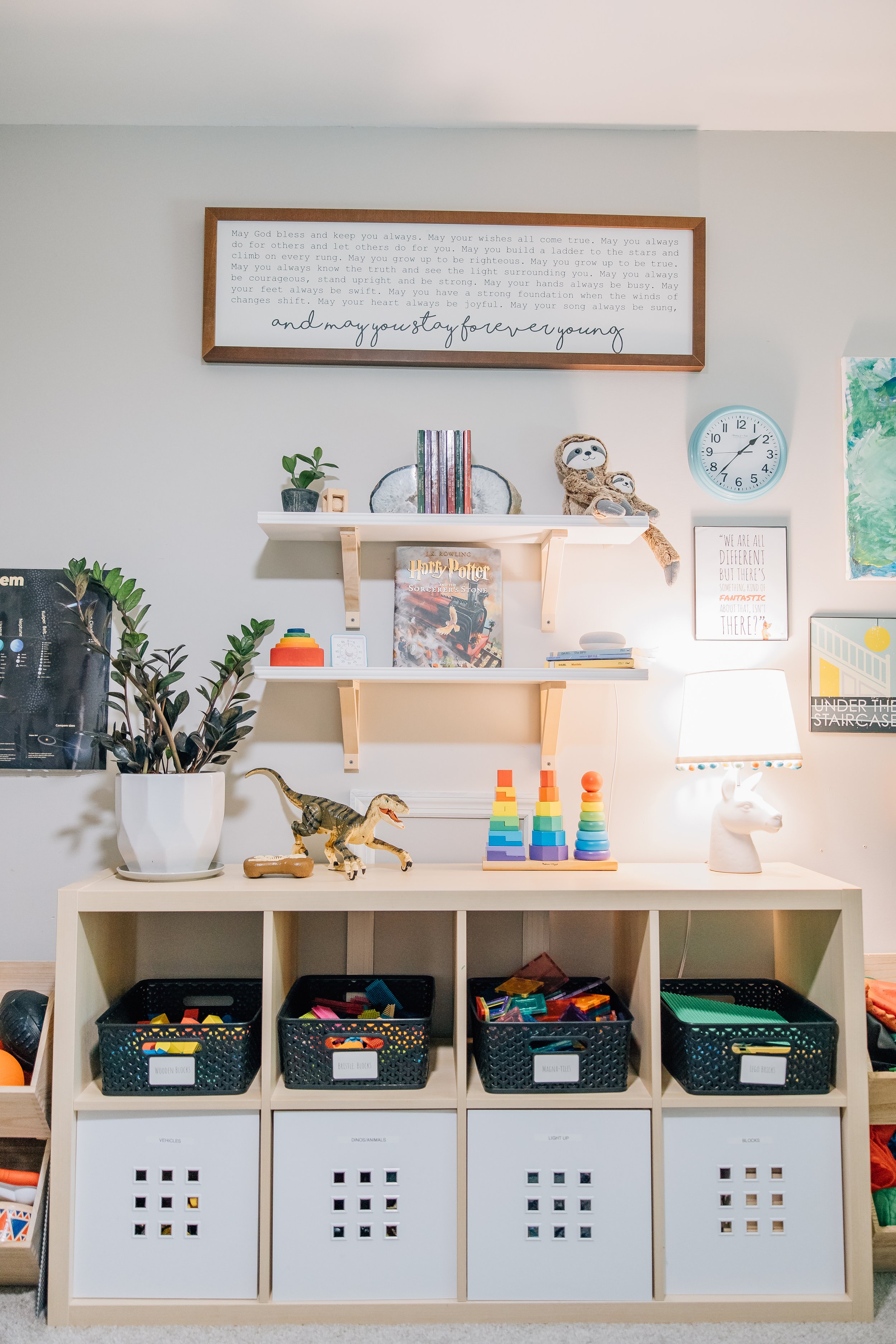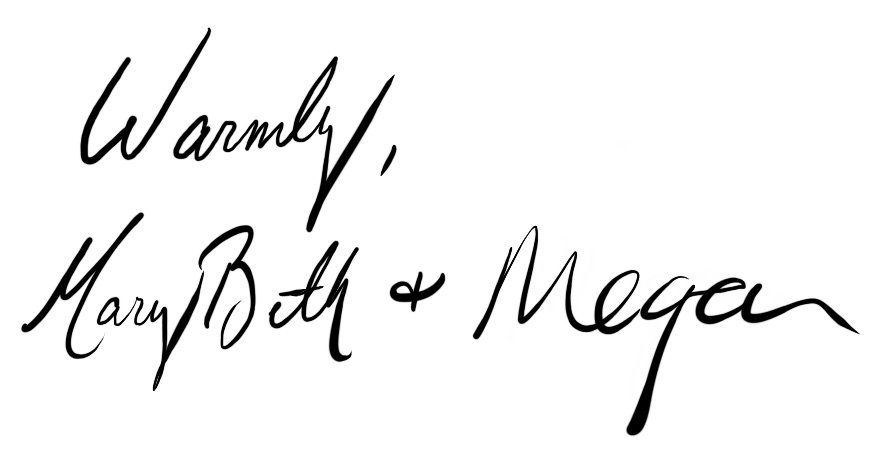The Less-But-Better Playroom
Mary Beth and I recently discovered that we are both reading the same parenting/minimalism book and it has inspired both of us to take a closer look at the play areas in our homes. The book is “Simplicity Parenting” by Kim John Payne. It was one of the first books I read when I was pregnant with my oldest and it was so formative for me! This book helped me articulate the benefits of what I knew deep in my gut: a slow, simple childhood is a beautiful childhood. And THAT is the childhood I want for my kids.
It has been a few years since I read it and re-reading it has been a much needed reminder for me that less is such a powerful tool for our family. It takes intention, observation, and constant questioning to keep our schedules and environments pared down in a society that praises busyness and productivity. In the vein of observation, I've noticed recently that my boys have been wanting to play more in our family room or their rooms instead of in our playroom. I've also noticed that when they are using the playroom, the quality of their play has changed. I'm seeing more bickering over toys, dumping things out and moving on to another activity before actually playing with the materials, and generally less deep, focused, collaborative play. One of my favorite things (though it can be a little scary too) is when the house gets really quiet. I usually poke my head in to make sure everyone is alive and often they are both so immersed in their work that they don't even look up. That child-directed “flow state” is such a joy to behold!
Why Less is More When it Comes to Toys
So how do we facilitate that awesome deep play? Research shows that fewer options are an excellent start!
A study from the University of Toledo observed 36 toddlers by inviting them to play in a room for 30 minutes with 4 toys or 16 toys. The researchers found that the children were more creative when they had fewer toys available to them AND they played with each toy for twice as long. The study suggested an increased number of toys creates distraction and overwhelm which reduces focused play.
Another benefit of taking a simplified approach to your child’s toys is the financial benefit of spending less money on toys! This could provide some room in your budget for fun new experiences, family trips, being able to spend more money in order to invest in higher quality toys that will grow with your child for years to come.
You're sold, right? Me too.
Try a Toy Rotation System
So, practically speaking, what does a minimal playroom look like?
In “Simplicity Parenting” Payne advocates for drastically reducing the number of toys children have access to at one time by creating “toy libraries” where toys that are not currently in use can be stored. I have used and loved the concept of toy rotation in our home. It keeps toys fresh and interesting, encourages deeper play, and reduces the amount of clean up. Toy libraries are just another way to rotate toys. Some families find that parent-led rotation without input from the children works well, while other families let children initiate toy checkouts or exchanges when they are ready for a new toy. I initially rotated our toys every Sunday as part of our Sunday Reset, but as my kids have gotten older, toys have begun to hold their interest longer. We now rotate roughly every 2 weeks or when I notice that they seem less enthusiastic about their materials. No toys are off limits, but they know that in order to get something new out they must put something else up. I read somewhere that one mom’s guidelines for how much to have available at one time was, “How much can they independently clean up in 5 min?”. Yes, ma’am. Sold.
Curate Your Toy Collection
In addition to the use of toy rotation, most of us can benefit from significantly reducing our overall toy inventory. We are a few years into our minimizing mission and I am typically pretty intentional about the toys we bring into our home. BUT even with mindful consumerism, kid’s toys are an area of our home that must be reassessed and edited frequently.
Ready to get started? Here are 10 questions I ask myself to help me choose what to toss:
Does it work? I like to start by removing anything that I'm unable to donate. Trash is usually easy to identify and removing it helps you build some momentum- think missing pieces, broken parts, junky party favors, prizes from the dentist’s treasure box, etc.
Can it be used over and over? Toys that are part of a “set” that once completed is unlikely to be used again - think building or craft sets.
Does it annoy you? Yup. This one is legit. Ideally they will be using their toys for hours of play…is this something you can listen to for hours? No? Time to rehome that sucker.
Is this a toy they are going to “grow into” or have already outgrown? Storing a few favorites for younger siblings is okay but the emphasis should be on a few. We also saved a couple of toys that had sentimental value but kept them to just a few and they are stored in the boys’ memory boxes rather than in the toy library.
Do we have multiple toys like this? Do you have 40 plush animals or 100 matchbox cars? Kids do not enjoy 100 speedy cars 100x more than 1 car. Consider making each toy more special by reducing the overall number within a category. We currently have 5 stuffies down from about 25 and now each of them have names, hobbies, and full backstories where before they were just one in the crowd.
Can this toy only be one thing? Is it “fixed”. Toys that are highly detailed can typically only be played with in one way and leave no room for imagination or creativity on the child’s part. The less a toy does the more a child has to engage with it. This might look like elaborate TV show character figurines or a fully detailed princess castle.
Do my kids actually play with this or just dump it on the floor? I usually give these another look once I've simplified the environment to see if the kids may have just been too overwhelmed by choices…but if I notice that they are still only dumping it out, buh-bye.
Is this a really high stimulation toy?
Is this toy inclusive and in line with our values? Do I want this toy to be part of my child’s life? Kids receive gifts all the time. We have gotten toys that range from mildly annoying to offensive. You don't owe it to anyone to keep gifts that represent other cultures, human bodies, family structures, or religions in a way that feels unkind to you. Toss it.
Am I leaving some empty space? Visual whitespace helps reduce overwhelm and provide actual physical, as well as mental, space for creative play. Our best fort situations happen when the room has plenty of blank space.
Devoting thoughtful time and attention to your children’s play spaces is a worthy investment. Mary Beth and I have both personally experienced the benefits of having fewer higher quality toys that meet the criteria we have set. Our homes are still loud and messy at times, but the play is a bit deeper, a bit more creative, and a bit more joyful. If you’re dreaming of a less but better playroom, give us a call! We’d love to obsess over your toy rotation system and care for your family through thoughtful organization.





